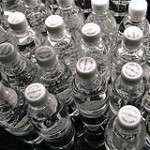by Catherine Haug
(Photos from Wikipedia)
Now that we are all grieving at the sight of oil-soaked pelicans in the Gulf, we call for an end to our dependence on petroleum. But have you ever thought about what all we’d have to give up? It’s not just fuel for our cars and home heating systems, or that airplane ride to our favorite vacation spot. We’d basically have to give up all that we’ve come to take for granted.
That’s what an article in June 13, 2010 Daily Interlake by Seth Borenstein, an AP Science Writer, titled Boycott Big Oil? Prepare to give up your lifestyle (1) is all about. It includes a litany of all the common, everyday things that contain substances made from crude, or depend upon crude for their maintenance or production.
It’s about what this means for our society; how far we have strayed from The Essential. “Petrochemicals are the glue of our modern lives and even in glue, too.” (1)
Here’s a partial list, from the article:
 cars and trucks
cars and trucks- bicycles
- shoes
- plastics
- air conditioners
- fast food milkshakes
- carpeting
- furniture
- computers
- clothing
- toothpaste
- shaving cream
- cosmetics
- deodorant
- supplements
Consider a bottle of shampoo. From Kevin Swift, director of economics and statistics for the American Chemistry Council (1):
“The bottle is plastic. The cap is plastic. The seal and the label, too. The ink comes from petrochemicals and even the glue that holds the label to the bottle comes from oil or gas. … The shampoo — it’s all derived from petrochemicals,” Swift said. “A bottle of shampoo is about 100 percent chemistry.”
And even if you can think of a product that doesn’t contain something made from petroleum, chances are it took energy generated by fossil fuels to produce it.
Living Green?
Want to live green? In this day and age, its next to impossible to live a lifestyle totally independent of big oil. Take solar panels, for example; how much fossil fuel energy was expended to mine the rare minerals? LOTS. Or take the so-called green insulating materials used in your home’s construction; many of these are made from oil, and fossil fuel energy is used to produce them.
We are so far removed from what is truly green and sustainable, its laughable!
And we’re paying for it too, even if you don’t count climate change. We pay for it in our own health. Again, from the AP article (1), regarding the substances (molecules) produced from crude:
“Unfortunately there’s a very dark side,” said Carnegie Mellon chemistry professor Terry Collins. He said the underlying premise of the petrochemical industry is that “those little molecules will be good little molecules and do what they’re designed for and not interact with life. What we’re finding is that premise is wrong, profoundly wrong. What we’re discovering is that there’s a whole world of low-dose (health) effects.
Many of these chemicals are disrupting the human hormone system.”
“Safe” Plastics
Just think about the recent news about plastic water bottles, and the coatings used inside canned food cans. One website asks the question: which plastics ARE safe? The answer? NONE, but some are worse than others.
From a 2004 article Care2.com: Which Plastics are Safe? (2)
“Polyethylene terephthalate (PET or PETE)
Used to make soft drink, water, sports drink, ketchup, and salad dressing bottles, and peanut butter, pickle, jelly and jam jars.
[Assessment] GOOD: Not known to leach any chemicals that are suspected of causing cancer or disrupting hormones.”
Notice the words “not known to“. This doesn’t mean it’s safe; it means they hadn’t yet discovered what makes it NOT safe. Since then, phthalates have been identified as potent hormone disruptors, especially for men. (3,4)
OK, so what about the new biodegradable plastics made from hemp, soy, rice or corn instead of crude? While they may be made from renewable vegetative matter, consider:
- How this quantity of vegetable material must be grown: on petrochemical fertilizers, pesticides and herbicides. And it’s probably GMO too.
- The huge expenditure of energy required to manufacture these ‘green’ plastics; where does it come from? Fossil fuels.
- Because these are synthetic molecules, produced in much the same way as petro-plastics, they have the same potential for health issues.
Green? its a laughable term. That is, unless you’re beyond laughable as you watch your grandchild reach sexual maturity at age 7.
References
- Boycott Big Oil? Prepare to give up your lifestyle
- Care2.com: Which Plastics are Safe?
- Phthalates
- Phthalate exposure and reproductive hormones in adult men (from Oxford Journal
See also my articles:

